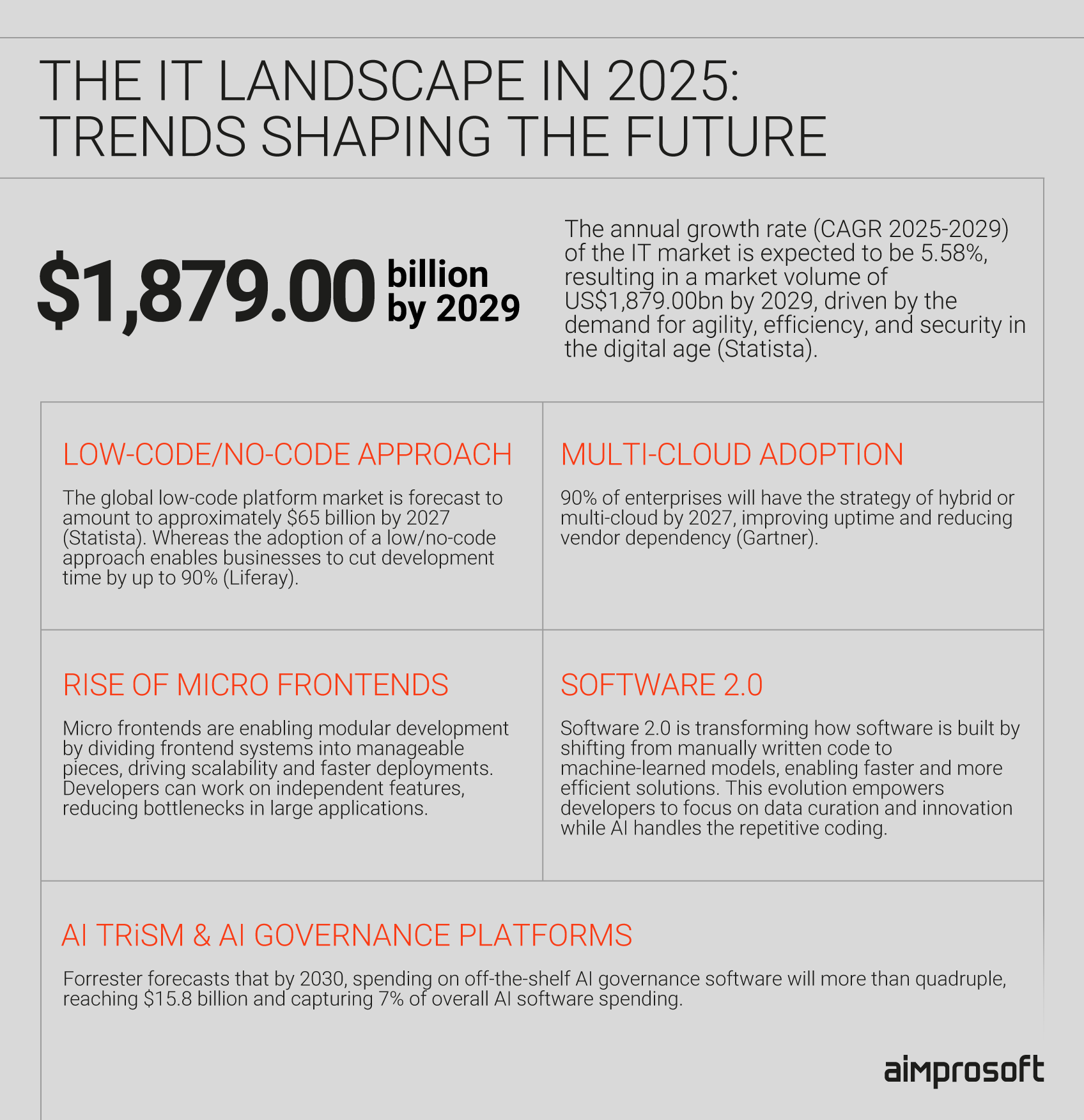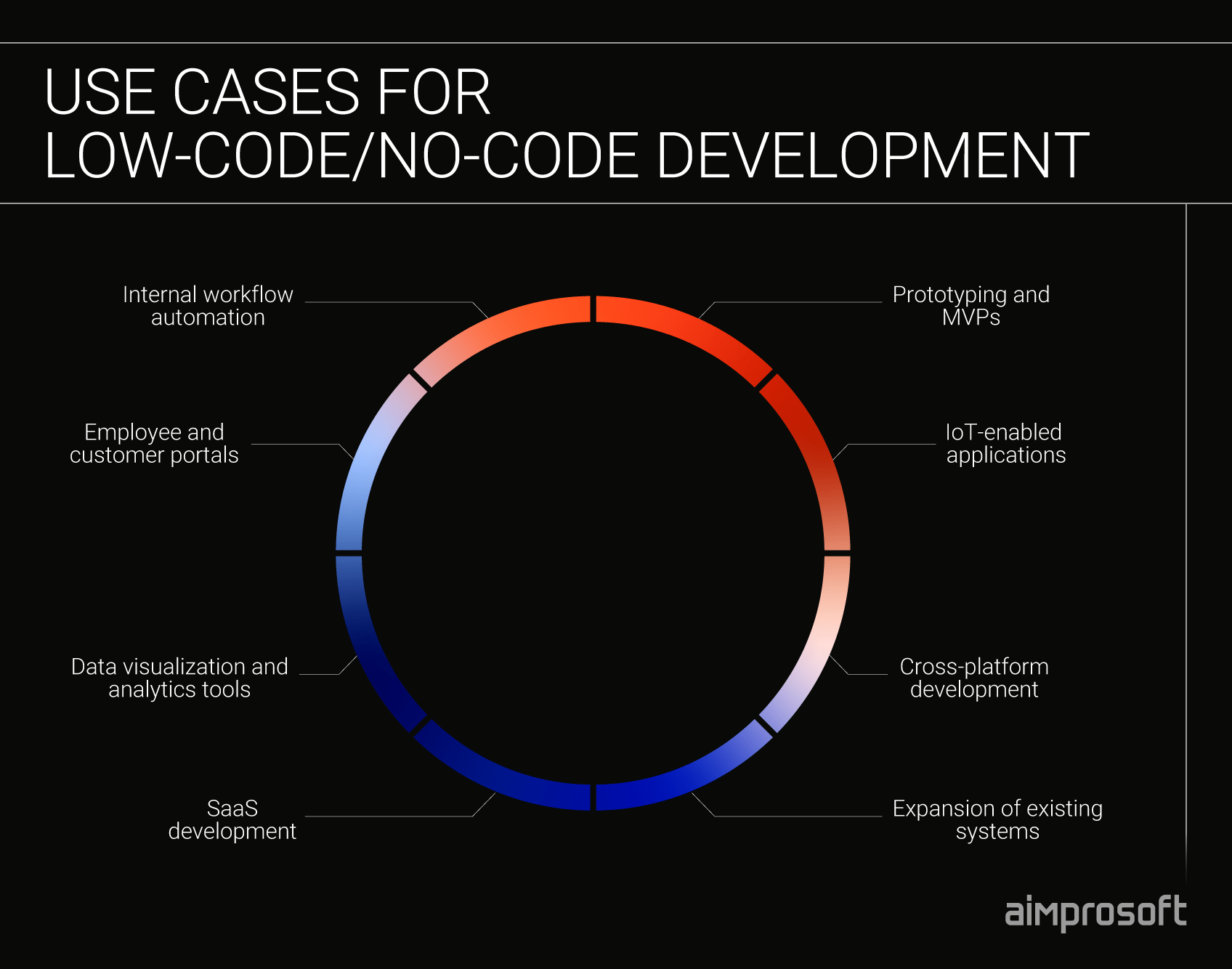Software Development Trends: Technology Predictions for 2025 and Beyond

Have you ever dreamt of a better version of your business? More agile, more innovative, more prepared for the future? One single strategy unlocks its potential, triggering a transformation that brings a whole new version of your organization to life.
Staying competitive means more than just keeping up; it’s about understanding the trends shaping the IT landscape and adapting them to unlock new opportunities. To stay afloat, businesses must continuously assess where they stand and where they’re headed.
The IT industry is undergoing a transformation at breakneck speed. From smarter automation to modular software architectures, the emerging trends are not just buzzwords but catalysts for growth. In this article, we’ll explore information technology trends that every decision-maker should have on their radar. From those that are redefining how software is developed and deployed to innovations enhancing scalability, security, and operational efficiency, we’ll cover 5 emerging technologies that are shaping the IT landscape in 2025.
The IT landscape in 2025: trends shaping the future
Over the past decade, the IT industry has undergone a remarkable transformation. Technologies that were once emerging trends in information technology, such as cloud computing, DevOps, and artificial intelligence, have become foundational to modern business operations. Worldwide IT spending is projected to reach $5.44 trillion by 2025, reflecting the sector’s rapid growth. Businesses that embraced these latest trends in information technology early on have already gained significant competitive advantages, reshaping industries and redefining customer expectations.

IT landscape in 2025
Currently, businesses are prioritizing flexibility and scalability to keep pace with shifting market demands. The adoption of AI and machine learning is growing rapidly, with 72% of surveyed organizations reporting they have implemented generative AI solutions as of January 2024, according to a McKinsey study of 1,363 participants.
Looking ahead to 2025, the focus is on emerging technologies in computer science that will redefine the IT landscape and shape the future of business technology. Business tech trends like low-code/no-code development, multi-cloud strategies, Software 2.0, and others explored in this article are poised to drive the next wave of digital transformation. As Steve Jobs famously said when he was reinstated as head of Apple Computers in 2007, “Let’s go invent tomorrow instead of worrying about what happened yesterday.” This mindset underscores the importance of forward-thinking strategies, encouraging businesses to embrace advancements that not only keep them competitive but also position them as leaders in an evolving digital world.
Staying informed about current trends in information technology isn’t just about chasing buzzwords; it’s about making informed decisions that align with long-term business goals. You can use these insights to:
- Identify transformative trends: Understand what is the future of software engineering and which emerging technologies for business have the potential to reshape industries and adopt them proactively.
- Explore real-world use cases: Learn from early adopters to see how others are leveraging merging and disruptive technologies to drive success.
- Align technology with business ambitions: Integrate trends that support enterprise digital goals and align with the organization’s strategic direction.
- Anticipate business and tech model shifts: Prepare for how these innovations might require adjustments to business processes and operations.
- Embrace strategic planning: Refine mid- and long-term strategies and adjust technology roadmaps to remain agile in a competitive market.
The organizations that succeed will be those that not only understand the emerging trends but act on them with foresight and purpose. Thus, future technology predictions explored in this article will not only shape how technology is developed and deployed but also redefine what it means to stay competitive in a digitally driven world, starting with the low/no-code development approach that we offer to discover in the section below.
Low-code/no-code development: simplifying software creation
For years, businesses have relied on two primary options for application development: purchasing pre-built solutions from external vendors or creating customized applications from scratch. However, the emergence and rapid advancement of low code/no code platforms is transforming this landscape, empowering businesses to actively participate in application development.
To understand what is low code no code platform, take a look at some of the most popular examples of low code/no code platforms, including platforms like Liferay DXP, Mendix, and OutSystems, which offer user-friendly interfaces, pre-built templates, and robust integration capabilities. These platforms are enabling organizations to develop tailored solutions quickly and efficiently, even with limited technical expertise.
The low code no code application development allows businesses to create functional software with minimal coding knowledge. By leveraging intuitive drag-and-drop interfaces and pre-built modules, organizations can bypass traditional development bottlenecks and high expenditures and bring ideas to life faster than ever before.
This approach is trending because it bridges the gap between technical and non-technical users, empowering businesses to innovate without waiting on overburdened IT teams. The trend adoption is driven by the demand for agility, cost efficiency, and faster go-to-market strategies in increasingly competitive industries and in organizations where change happens quickly. Unsurprisingly, the global low-code platform market is forecast to reach approximately $65 billion by 2027.

Use cases for low/no-code development
Key characteristics of low-code/no-code development
At its core, no code low code solutions are designed to simplify and accelerate software creation by providing tools that minimize the need for traditional coding. These platforms are defined by specific features that cater to both technical and non-technical users, such as:
- Visual development interfaces
Users can design applications through intuitive drag-and-drop tools, reducing reliance on traditional coding. - Pre-built modules and templates
Ready-made components for common functions (e.g., interface elements, database connectors, authentication, data visualization) help with quick application assembly. - Integration-friendly frameworks
Low code no code technology often supports seamless integration with APIs and other software, enabling connectivity across systems. - Automated backend processes
Thanks to low code no code automation, complex backend tasks, such as database management or server configuration, are automated, streamlining development workflows. - Customization with minimal coding
While no-code platforms are fully code-free, low-code platforms allow tech-savvy users to write small amounts of custom code for additional flexibility.
What are the benefits of low-code/no-code development?
The rising popularity of low-code/no-code tools is fueled by the tangible benefits they offer to organizations. By using these platforms, businesses can achieve critical goals such as faster product delivery, cost reduction, and greater collaboration across teams.
- Faster time-to-market
Businesses can launch applications in weeks rather than months, responding more quickly to market demands. According to the research, low-code/no-code solutions can potentially reduce development time by up to 90%. - Cost savings
With fewer developer hours required, companies can significantly reduce software development costs. - Increased business agility
Prototyping, iterative changes, and updates are simpler to implement, making low-code/no-code platforms ideal for dynamic business environments. - Reduced dependency on IT teams
Non-technical team members, such as product managers or business analysts, can actively contribute to software creation, fostering innovation across departments. Business units can take ownership of their projects without overloading IT departments, which can focus on strategic priorities. - Risk mitigation
Such solutions can help avoid development risks as they provide a controlled environment with pre-tested components, modules, designed patterns, workflows, and standardized processes. This reduces the chances of introducing vulnerabilities or inconsistencies, ensuring that applications are built on reliable foundations and adhere to best practices from the start.
When should you follow this trend?
While low-code/no-code platforms are incredibly versatile, they aren’t a universal solution for all business needs. It’s essential to understand when adopting this approach aligns with your business objectives and when a more traditional development process may be a better option.
Adopt low-code/no-code development if:
- Your organization needs to quickly develop internal tools or customer-facing applications.
- You face a shortage of skilled developers or lack the necessary resources to hire them and want to empower non-technical staff.
- Agility is critical for your business, such as responding rapidly to customer demands or market shifts.
Avoid low-code/no-code development if:
- You require highly customized, scalable, or performance-intensive applications that exceed the capabilities of most platforms.
- Security and compliance are paramount, and platform-specific limitations could create vulnerabilities.
- Your team already has robust development expertise and prefers full control over the developed product.
Drop us a line, and let’s discuss how we can help you unlock faster time-to-market, cost efficiency, and simplified workflows with this approach.
CONTACT USOverall, low-code/no-code development is transforming the way businesses approach software creation, offering speed, accessibility, and cost efficiency. While it’s not a silver bullet solution for every scenario, its ability to empower non-technical users and streamline development makes it a rather helpful instrument. By understanding its potential and limitations, you can use it to stay agile and competitive.
Multi-cloud adoption: balancing agility and resilience
The growing complexity of modern business operations has pushed multi-cloud adoption to the forefront of IT strategies. By adopting a multi-cloud approach, you can use a combination of cloud services from multiple providers to distribute workloads, optimize performance, and mitigate risks.
Being one of the most popular cloud technology trends, multi-cloud is gaining traction as businesses seek new approaches to balance cost-efficiency, system resilience, and flexibility. According to the OVHcloud survey, in which more than 500 large organizations participated, 62% of organizations are currently using a multi-cloud environment, with a further 18% actively in the process of transitioning to a multi-cloud environment.

Reasons to opt for multicloud
Why is multi-cloud adoption one of the most popular cloud computing trends and is so rapidly adopted? Enterprises are increasingly wary of vendor lock-in, where relying on a single provider limits options and creates potential vulnerabilities. With the rise of global data privacy regulations and diverse workload demands, a multi cloud strategy offers a way to align technology with business needs while maintaining agility and control.
Key characteristics of multi-cloud
- Diverse cloud environments
A multi-cloud model incorporates multiple cloud providers (e.g., AWS, Azure, Google Cloud) within the same IT infrastructure, each chosen for its strengths in specific workloads or services. - Interoperability
Integration tools and APIs enable seamless communication and data exchange between different cloud platforms, ensuring smooth operations across a multi cloud environment. - Workload portability
You can allocate workloads based on performance, cost, or geographic proximity, using the best-suited cloud for each task. As Matt Tebay, sales director at OVHcloud, explains: “Using the right cloud for the right workload is rapidly being accepted as the best way to do business today.” This approach ensures resources are used efficiently while maintaining flexibility to adapt to specific needs. - Fault-tolerant design
Multi-cloud environments inherently incorporate fault tolerance by leveraging multiple providers, ensuring that no single point of failure can disrupt operations. - Regulatory compliance flexibility
Multi cloud management software allows data to be stored in regions that meet local compliance requirements, addressing global privacy standards.
Benefits of multi-cloud adoption
- Improved resilience
With workloads distributed across providers, businesses are less vulnerable to outages or failures from any one cloud service. - Cost efficiency
Organizations can choose cost-effective options for specific workloads, optimizing their overall IT spend. - Greater flexibility
Multi-cloud allows adapting quickly and orchestrating application delivery in multi-cloud environment, using the latest innovations or better solutions from competing providers. - Global reach
Using multiple providers enhances geographic coverage, improving latency and performance for users worldwide. - Vendor independence
Avoiding over-reliance on a single provider ensures businesses maintain negotiating power and flexibility in their IT strategies. - Enhanced performance and agility
Multi cloud network architecture enables businesses to use the fastest and most reliable infrastructure from multiple providers, ensuring high-speed performance while maintaining flexibility and resilience.
When you should follow this trend and when not
Adopt multi-cloud if:
- Your organization requires high availability and cannot afford downtime.
- You operate in multiple regions with varying compliance and data sovereignty requirements.
- You want to optimize infrastructure-related expenditures by using the best pricing for different workloads.
Avoid multi-cloud if:
- Your team lacks the expertise or tools to manage complex multi-cloud environments, and opting for multi cloud management services isn’t an option.
- Your workloads don’t require high availability or specialized cloud features.
- You can achieve your business goals with a single, well-suited cloud provider.
Multi-cloud adoption is more than a trend, it’s shaping the future of cloud computing in software, becoming a strategic approach to managing the demands of modern IT environments. By leveraging the strengths of multiple providers, businesses can achieve greater resilience, flexibility, and cost efficiency. However, success depends on understanding your specific needs and ensuring your team is equipped to manage the complexities of multi-cloud operations. Choose wisely, and multi-cloud can be a game-changer for your business.
Rise of micro-frontends: modular frontend architecture for scalability
The evolution of frontend development has brought about micro-frontends. But what is micro-frontend exactly? It’s a modern architectural approach that breaks down monolithic frontend applications into smaller, independent modules. Each module, or “micro-frontend,” is managed by different teams, developed independently, and can use its own technology stack (e.g., micro frontend in Angular or micro frontend in React).
Micro-frontend architecture trend is reshaping how large-scale applications are built, enabling teams to deliver features faster and with greater autonomy. Some of the popular companies that already adopted this approach are: Spotify, IKEA, Zalando, Upwork, and many others. While Sep Nasiri, a representative from Upwork, acknowledges that “migrating to a micro frontend design posed some hurdles,” the move ultimately allowed the platform to streamline services and enhance the user experience for its over 18 million global registered users. The benefits of modernization, as Nasiri highlights, make the effort worthwhile, helping businesses future-proof their systems and deliver more consistent experiences.
To understand the essence of this architecture better, take a look at the micro frontend example in the image below:

Example of a micro-frontend architecture
Micro frontends are trending because of their ability to enhance scalability and agility in development. As businesses demand rapid adaptation to changes and better user experiences, this approach ensures that updates can be rolled out without disrupting the entire system. For organizations transitioning to microservices architecture, micro frontends provide the frontend counterpart, completing the modular design.
Key characteristics of micro-frontends
Micro frontends offer unique features that make them stand out from traditional monolithic approaches. Here’s what defines this architecture:
- Modularity
Micro frontend architecture is divided into independent modules, each representing a specific feature or section of the user interface. - Technology independence
Teams can use different micro frontend framework or libraries (e.g., React, Angular, Vue) for each micro frontend without affecting the rest of the application. - Team autonomy
Different teams can own and develop their modules independently, reducing dependencies and bottlenecks. - Incremental updates
Changes can be made to individual modules without requiring a full system redeployment, ensuring faster delivery cycles. - Seamless integration
Micro frontends are designed to integrate seamlessly into a cohesive user experience, even if different technologies are used.
Benefits of micro-frontends
The rise of micro frontends is fueled by their tangible benefits. Here’s what businesses and developers gain from adopting this approach:
- Improved scalability
Modules can be scaled independently, enabling better resource allocation and performance optimization. - Faster development cycles
With independent teams working on different modules, features can be developed and deployed in parallel. - Reduced risk
Errors or failures in one module don’t impact the entire application, enhancing its stability. - Technology diversity
Teams have the freedom to choose the best technology for each module, enabling innovation and flexibility. - Enhanced collaboration
Micro frontends align well with agile methodologies, allowing cross-functional teams to work simultaneously without stepping on each other’s toes.
When you should follow this trend and when not
While micro frontends offer significant advantages, they aren’t a one-size-fits-all solution. Here’s how to evaluate their relevance to your business:
Adopt micro-frontends if:
- Your application is large and complex, with multiple teams managing different features.
- You’re already using a microservices architecture and want to align the frontend with the backend.
- Agility and faster delivery cycles are critical for your business.
Avoid micro-frontends if:
- Your application is small or straightforward, where the added complexity of micro frontends isn’t justified.
- Your team lacks the expertise or tools to manage a distributed architecture.
- Ensuring a seamless user experience across diverse technologies is beyond your current resources.
Micro frontends represent a significant leap forward in frontend development, offering scalability, flexibility, and faster delivery cycles for large-scale applications. While they bring added complexity, their benefits in modularity and team autonomy make them a compelling choice for businesses prioritizing agility and innovation. By carefully evaluating your needs, you can determine whether micro frontends are the right fit for your organization’s goals.
Software 2.0: the evolution of software development and developer roles
The rise of Software 2.0 is a game-changer for the tech industry, marking a shift from traditional software development to AI-driven development. Unlike Software 1.0, where developers manually wrote lines of code to define every logic and function, Software 2.0 leverages machine learning models that learn and generate code based on data. This transformation is creating a new kind of software development, where AI assists or even takes over the task of building, optimizing, and maintaining software systems.

This trend is gaining momentum as businesses seek to develop more intelligent, adaptive, and scalable software solutions. Software 2.0 offers unprecedented speed, efficiency, and the ability to handle complex problems, making it a powerful tool for organizations looking to stay ahead in the digital race. As developers shift from traditional coding practices to training machine learning models, the nature of software development itself is evolving.
Key characteristics of software 2.0
Software 2.0 is distinct from traditional software development in several key ways. Here’s what sets it apart:
- AI-driven development
Instead of writing explicit code, developers curate datasets to train machine learning models that generate software solutions. - Data-centric approach
Software 2.0 emphasizes data over traditional code. The quality and volume of data are more important than the individual lines of code written. - Model training and tuning
Developers focus on creating and optimizing machine learning models, adjusting hyperparameters, and ensuring the model is producing the desired outputs. - Automated code generation
With tools like GitHub Copilot, AI assists developers by suggesting and generating code, reducing the time spent on manual coding tasks. - Continuous learning and adaptation
The software built following the Software 2.0 approach can continue to improve by learning from new data and feedback, reducing the need for manual updates.
How is the role of the developer evolving?
The rise of Software 2.0 is fundamentally transforming the role of the developer, introducing new responsibilities and skill sets:
- From coders to data curators
Developers now focus on preparing, cleaning, and labeling datasets to ensure AI models are trained on high-quality data. - AI model training and fine-tuning
Writing code is replaced by designing and optimizing machine learning workflows, requiring a deeper understanding of AI frameworks - Cross-disciplinary collaboration
Developers work closely with data scientists, product managers, and business leaders to align AI outcomes with organizational goals. - Emphasis on explainability
Developers must ensure AI systems provide interpretable results, bridging technical and ethical considerations. - New skills in demand
Proficiency in AI tools, data engineering, and ethical AI practices is becoming essential for developers to remain competitive.
For businesses, this shift means that developer teams must adapt quickly to new approaches, but it also opens up new opportunities for faster development cycles, more innovative software solutions, and deeper insights from data. The traditional developer role is evolving into a more strategic one, where developers are integral to driving the business’s digital transformation.
While AI programming assistants (such as Open AI’s ChatGPT, GitHub’s Copilot, Amazon’s CodeWhisperer) will not replace human developers, an Ark Invest report predicts generative AI platforms could enhance productivity tenfold by taking over mundane and boilerplate tasks. This allows developers to focus on more complex, higher-value challenges, further emphasizing their role as drivers of innovation.
Benefits of Software 2.0
Software 2.0 is not just a technological advancement; it brings concrete business benefits. Here’s why organizations should embrace this trend:
- Faster time to market
AI-driven software development can reduce the time needed to build, test, and deploy software, accelerating innovation. - Improved scalability
By leveraging AI to handle complex tasks, businesses can develop scalable systems that adapt and grow with the business needs. - Cost efficiency
Reduces the need for extensive manual coding and ongoing maintenance, lowering overall development costs. - Increased agility
Software 2.0 enables businesses to iterate faster, incorporating feedback and improvements more quickly through continuous learning and model updates. - Enhanced problem-solving
AI models can tackle problems that traditional software development struggles with, like real-time predictions and complex pattern recognition.
When you should follow this trend and when not
While Software 2.0 holds great potential, it may not be the right fit for every situation. Here’s when you should consider adopting this trend:
Adopt Software 2.0 if:
- Your business needs to handle complex, data-intensive problems, like predictive analytics or real-time decision-making.
- You want to accelerate development processes and improve the speed of delivering new features.
- Your organization is already collecting large amounts of high-quality data that can be used to train AI models.
Avoid Software 2.0 if:
- Your applications are relatively simple and don’t require the level of complexity or adaptability offered by AI-driven development.
- Your organization lacks the necessary resources or expertise to manage the transition to machine learning-based systems.
Software 2.0 is transforming the way software is developed, bringing AI-driven automation and efficiency to the forefront of development practices. While the evolution of the developer role presents both challenges and opportunities, businesses that embrace this change can achieve faster development cycles, better scalability, and more intelligent solutions. However, it’s crucial for businesses to assess whether the complexity and resources required for Software 2.0 align with their current needs and future goals.
AI TRiSM & AI governance platforms: building trust in intelligent systems
As artificial intelligence becomes a cornerstone of modern business operations, ensuring its ethical, secure, and efficient use has become critical. AI TRiSM (Trust, Risk, and Security Management), combined with robust AI governance platforms, provides a framework for organizations to manage AI systems responsibly.
These tools and practices ensure that AI systems are not only powerful but also explainable, fair, and aligned with business goals. With the global AI TRiSM industry projected to reach $7,444.9 million by 2030, growing at a compound annual rate of 21% from 2024 to 2030, it’s clear that organizations worldwide are prioritizing trust, security, and accountability in their AI strategies.
In turn, AI governance platforms are specialized tools designed to help organizations monitor, manage, and control AI systems throughout their lifecycle. They offer features like automated bias detection, explainability metrics, compliance tracking, and risk mitigation frameworks. By centralizing oversight, these platforms ensure that AI automation tools remain reliable, ethical, and compliant with regulatory standards, even as they evolve.
These emerging AI technologies and approaches are gaining traction as AI in software development accelerates across industries, exposing businesses to new risks such as bias, security vulnerabilities, and regulatory challenges. By integrating AI TRiSM principles and AI governance framework, organizations can mitigate these risks while maximizing AI’s potential to drive innovation and efficiency.
Key characteristics of AI TRiSM & AI governance platforms
The six pillars of AI TRiSM form the foundation for responsible and effective AI management. Here’s what each entails:

Main pillars of AI TRiSM
Key characteristics of AI governance platforms
To understand what is AI governance platform and what is AI governance in general, it’s important to explore the key characteristics of such solutions. AI data governance platforms are a critical component of the broader AI TRiSM framework, acting as the operational backbone to manage trust, risk, and security in AI systems. These platforms bring a suite of specialized features designed to ensure AI models are deployed responsibly, ensure secure ai assisted software development, and remain aligned with business goals:
- Centralized model management
Offers a unified interface to oversee all AI models, ensuring streamlined monitoring, versioning, and updates. - Automated compliance monitoring
Tracks AI system adherence to regulatory and ethical standards, providing real-time alerts for potential violations. - Bias and fairness tools
Built-in functionalities to detect and mitigate biases in models, ensuring equitable outcomes and maintaining trust. - Explainability and transparency tools
Features that allow stakeholders to interpret and understand AI decisions, improving accountability and user confidence. - Robust security features
Includes protections for AI models, such as encryption, access controls, and safeguards against adversarial attacks. - Performance optimization
Continuously evaluates AI system performance, identifying areas for improvement to maintain efficiency and reliability.
These characteristics empower organizations to maintain control over their AI ecosystems, fostering trust and ensuring compliance with ever-evolving regulations.
Benefits of AI TRiSM & AI governance platforms
Adopting AI TRiSM principles and governance platforms offers significant advantages. Here’s why businesses are prioritizing this trend:
- Enhanced trust
Transparent and explainable AI systems build confidence among users, stakeholders, and regulators. - Risk mitigation
Addressing vulnerabilities like bias, security risks, and model drift reduces the likelihood of AI-related failures. - Regulatory alignment
Generative AI governance platforms streamline compliance with evolving data protection and AI regulations, avoiding fines and reputational damage. - Improved efficiency
AI business process automation through ModelOps ensures AI systems remain effective, reducing the need for manual intervention. - Scalable AI adoption
Well-governed applications of generative AI enable businesses to scale AI initiatives confidently and responsibly. - Stronger security
AI AppSec aims to protect sensitive data and prevent malicious attacks, safeguarding both business assets and customer trust.
When you should follow this trend and when not
AI TRiSM and governance platforms are essential for many organizations, but they might not always be the right fit. Here’s how to assess their relevance:
Adopt AI TRiSM & AI governance platforms if:
- Your organization heavily relies on AI systems for decision-making or operations.
- You operate in industries with stringent compliance requirements, such as finance, healthcare, or government.
- Your AI systems impact diverse user groups, where fairness and transparency are critical.
Avoid AI TRiSM & AI governance platforms if:
- Your AI use cases are limited in scale or impact, where simpler governance methods suffice.
- Your organization lacks the resources or expertise to manage comprehensive governance frameworks.
- AI adoption is experimental, with no immediate plans for scaling or production-level deployment.
Discover how AI is shaping the future of business and society. Explore its transformative impacts and discover AI-related trends that every decision-maker should know.
AI TRiSM and governance platforms are no longer optional; they’re shaping the future of software engineering and are essential for organizations looking to leverage AI responsibly and effectively. By focusing on transparency, security, and accountability, these frameworks ensure AI systems are not only powerful but also ethical and trustworthy. For businesses embracing AI at scale, adopting AI TRiSM principles is the key to unlocking AI for business automation while managing risks.
Wrapping up
The IT landscape of 2025 is defined by innovation, agility, and the relentless pursuit of efficiency. From the transformative power of low-code/no-code development to the strategic flexibility of multi-cloud adoption, the modular strength of micro frontends, the trust-building frameworks of AI TRiSM and governance platforms, and the revolutionary shift of Software 2.0, these emerging trends in software engineering are reshaping how businesses approach technology. While each trend offers unique opportunities, success lies in understanding their potential, evaluating their relevance, and integrating them thoughtfully into your organization’s strategy.
Staying ahead in this evolving digital age isn’t just about keeping up, it’s about choosing the latest trends in software development that align with your vision and business goals. Let us help you navigate this journey and unlock the potential of these innovations. Contact us today to discover how we can turn these trends into solutions tailored to your business.
FAQ
Are these trends relevant for small and medium-sized businesses?
While some trends in computer science and information technology, like multi-cloud adoption or AI governance platforms, are often associated with larger enterprises, many are scalable and can bring significant benefits to SMBs. Great examples of small business tech trends are low/no-code development and the rise of micro-frontends. Low-code/no-code development enables smaller teams to build applications quickly without extensive resources, and micro frontends can help modularize even modestly complex systems.
Is adopting these trends expensive or resource-intensive?
It depends on the trend and your starting point. Some software development trends, like low-code/no-code, offer cost-efficient entry points with minimal upfront investment. Others, such as AI TRiSM or Software 2.0, may require more substantial investments in training, infrastructure, or expertise. However, the long-term benefits, such as improved efficiency, scalability, and innovation, often outweigh the initial costs. Partnering with experienced vendors can help reduce implementation complexity.
What if my team lacks the expertise to implement these trends?
Many of these emerging trends in IT that shape the future of software development come with tools, platforms, or services designed to make adoption easier, even for teams with limited expertise. For example:
- Low-Code/No-Code platforms are user-friendly and often require little to no coding knowledge.
- Managed services and consulting for multi-cloud strategies and AI TRiSM can bridge skill gaps.
- If you need to outsource AI/ML development services, consider working with an experienced AI ML development company or vendor who can guide your team through adoption, training, and integration.
How do I determine which trend is the best fit for my business?
Start by assessing your business goals, current challenges, and available resources. For example:
- If you need faster application development with minimal coding, low-code/no-code might be the answer.
- For businesses seeking greater resilience and flexibility, multi cloud architecture adoption can provide operational benefits.
- If your organization relies heavily on automation and AI, AI TRiSM ensures secure, compliant, and ethical AI operations.
- Conducting a discovery phase with experts can help tailor these IT automation trends to your specific needs.




